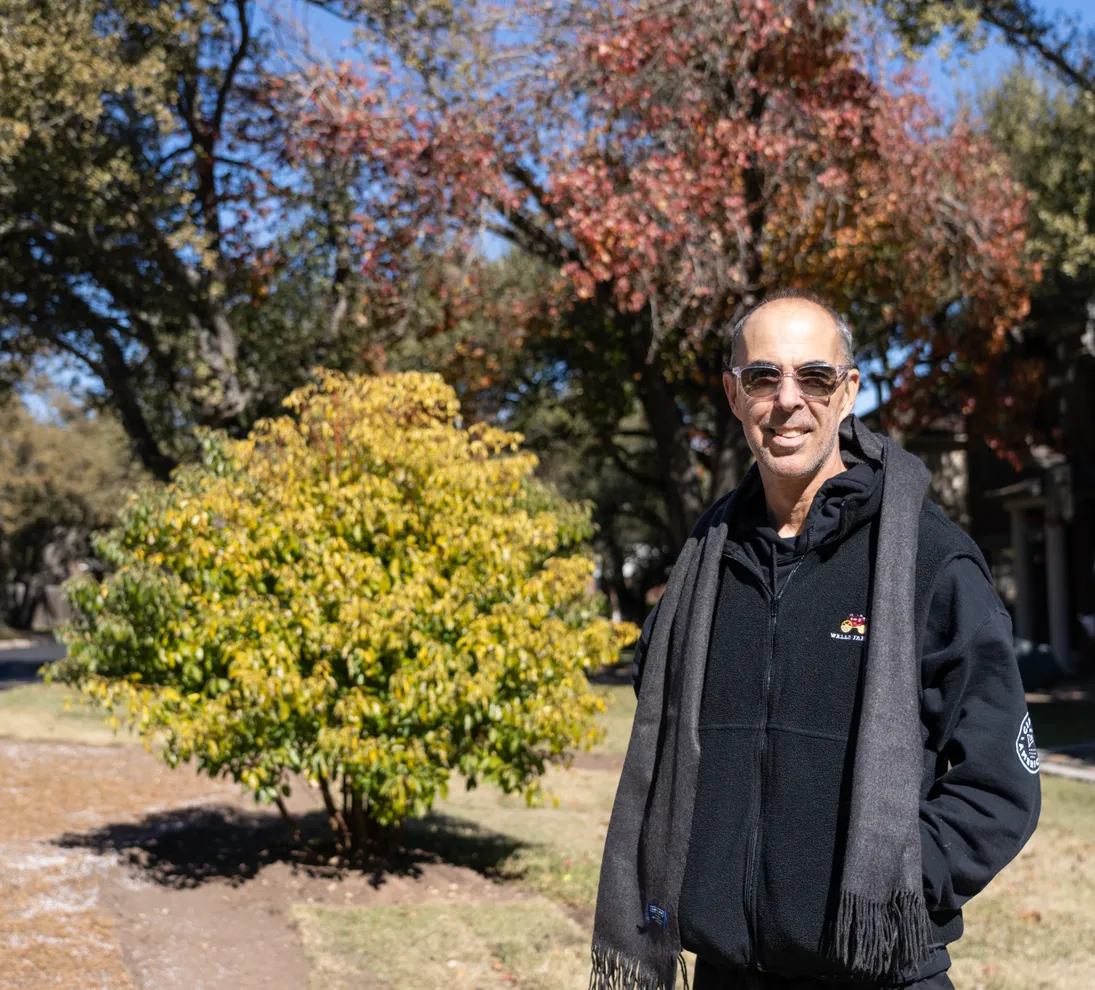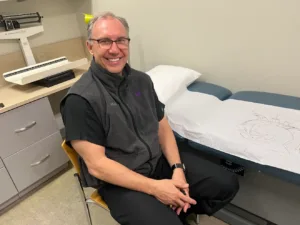CTVS patient, William Penny, shared his aortic dissection story with Nicole Villalpando from the Austin American Statesman to help raise awareness about heart health during American Heart Month. You can read his story below or find it on the Austin American Statesman website here.
Will Penny and his wife were going for a run on Oct. 30 in their Northwest Austin neighborhood. It wasn’t even a difficult run, just 2.1 miles, something they had done regularly.
This time, though, as he approached a hill, he had to stop, first at a utilities box, then on a bench. He felt a pain in his diaphragm, almost like indigestion, but nothing like he had felt before.
“It was somewhat debilitating,” he said. “I knew there was something that needed attention.”
His wife ran back home to get him some water and brought the car to bring him home.
Even though Penny, 55, knew something wasn’t right, he was hoping it would go away. But even after dinner and resting, the pain was still there. Finally, at 9 p.m., he decided to go to an urgent care center before it closed for the night an hour later.
An intense pain that isn’t going away
There the lone doctor examined him and gave him an EKG to look at how his heart was functioning. It wasn’t a heart attack, but it was concerning. That doctor sent him across the street to the emergency department at St. David’s North Austin Medical Center.
“Stuff got real,” Penny said. While he doesn’t remember all of it, a CT scan quickly revealed the problem. Penny had a large dissection of his aorta that needed to be repaired immediately. By 4 a.m., he was in surgery having a new aortic arch put it and its connection to major blood vessels repaired.
The diagnosis was a shock to Penny. “I think of myself as healthy,” he said.
The aorta is the major artery that brings blood from the heart to the rest of the body. In Penny’s case, his dissection, where the layers of the wall of the aorta separated, wasn’t close to the heart, which is more typical and less complicated to fix. Instead it was at the top of the aorta in the aortic arch and affecting the large branch vessels that go to the brain and his right arm.
“His was a doozy,” said Dr. Jeffrey Apple, a vascular surgeon with Cardiothoracic and Vascular Surgeons in Austin, who worked on Penny along with W. Chance Conner, also with Cardiothoracic and Vascular Surgeons, who did the initial replacement of the aortic arch.
If Penny had been in a rural hospital that didn’t have cardiovascular specialists and had to be taken to Austin, Houston or Dallas, “I don’t know if he would have made it,” Apple said. The blood would have collected around the heart and killed him.
Why do aortic dissections happen?
Both Apple and Conner say the typical person with an aortic dissection is someone with a history of high blood pressure and/or aneurisms, either from the high blood pressure weakening the blood vessels or by a connective tissue disease such as Marfan syndrome. It’s more common in men and factors like obesity and smoking increase the risk.
Conner explains that during an event of increased pressure on the aorta either because of stress or exercising or another reason, the inner layer of the aorta tears and blood enters the middle layer of the aorta and can actually flow backward to the heart. That backward flow can cause extreme pressure on the heart, damaging it and the aortic valve, and leading to death.
This is an emergency, Conner said. About 50% of people who have an aortic dissection die at home. Of the other 50% who make it to the hospital, he said, 90% will die within a week or two if nothing is done. The mortality rate of this surgery can be 30% to 50% depending on the severity and the health of the patient.
Penny had his relatively good health on his side, but the size and placement of the tear was a challenge.
A problem that can be corrected proactively
Those mortality percentages are why doctors want to follow patients who have risk factors such as high blood pressure or a history of aneurysms — a weakening of a blood vessel causing an enlargement or bulging or ballooning of the wall of the blood vessel.
They should be monitored regularly with a CT scan and when that aneurysm grows to around 5 centimeters, doctors will go in a repair the aneurysm before it causes a dissection. That surgery’s risk is only about 8% mortality.
When that tear happens it typically is extremely painful and usually there is no mistaking that you are having an emergency. Because Penny’s dissection wasn’t as close to the heart, he didn’t feel chest pain but instead felt that stomach pain.
Repairing the heart while protecting the brain
Conner knew this would be a very complex surgery, and he would need to clamp off the blood supply to the right side of the brain while using a catheter to continue blood flow to the left side of the brain.
He knew he’d be affecting the brain for a longer period than a typical aortic graft, so instead of cooling the body to 82 degrees, he cooled Penny to 64. That allowed Conner to have 30 to 40 minutes to work on the area where the aorta connects to the vessel leading to the right side of the brain instead of the typical 20 minutes.
Conner knew there were significant risks and that they wouldn’t know how well they had protected Penny’s brain or if any organs had been damaged until Penny woke up after surgery. He also knew this surgery would be the first phase to get Penny out of the immediate danger.
Penny, though, woke up and showed clear signs of typical brain function as well as good kidney function. Until Penny woke up in the intensive care unit and saw the amount of tubes coming out of him, he didn’t fully understand what had happened and the severity of the situation.
“I escaped a lot worse outcome,” he said.
He was in the intensive care unit for seven days and then able to go home, but with restrictions. They could not start physical therapy because Penny needed to heal and then have the second phase surgery.
In that procedure, Apple went through the femoral artery and an artery in the right arm to add two stents to open up the blood vessels leading to the right brain and the right arm. Penny was having dizziness and decreased blood flow to those areas. Apple also did a bypass to the artery going to the right arm.
Creating a chronic, treatable condition
With those two phases, Penny now has a chronic condition that will be monitored instead of an emergency. He will have yearly CT scans to look at the aorta. While the stents will last forever, the aortic graph might need to be replaced if it shows wear. They also will be looking for more dissections and aneurysms in other areas of the aorta that were not replaced.
His blood pressure will be well monitored for the rest of his life to try to prevent aneurysms and dissections.
Penny expects to be running again in six to nine months, but nothing that would be grueling on the heart, like a marathon, Conner said. The one thing Penny did have to give up is driving a race car because of the open heart surgery and the risk of a severe impact to the chest.
“I do feel much better physically,” Penny said. “I’m getting stronger.”
Courtesy the Austin American Statesman
Image credit Mikala Compton/Austin American Statesman


